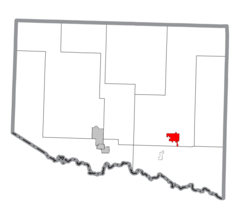Climate
Michigan State University's study of Crystal Falls weather concluded that precipitation was well distributed throughout the year with the crop season, April–September, receiving an average of 20.30 inches (516 mm) or 68% of the average annual total for the 1962-80 period. During this same period the average wettest month was June with 3.96 inches (101 mm), while the average driest month was February with 1.02 inches (26 mm). The National Weather Service's 1971–2000 data shows a 30-year normal annual precipitation of 29.65 inches (753 mm).
The following precipitation extremes, based on the time period of this station's published record, are: greatest observation-day total, 3.86 inches, recorded June 14, 1981; greatest monthly total, 12.48 inches, recorded June 1981; and least monthly total, 0.00 inches, recorded on several occasions.
Summer precipitation comes mainly in the form of afternoon showers and thundershowers. Annually, thunderstorms will occur on an average of 33 days. There are normally 139.2 days with measurable precipitation.
The 1950-51 through 1979-80 average seasonal snowfall was 70.6 inches (1.79 m). During this period, 143 days per season averaged 1-inch (25 mm) or more of snow on the ground, but varied greatly from season to season.
The following snowfall extremes, based on the time period of this station's published record, are: greatest observation-day total, 18.0 inches, recorded March 7, 1926; greatest monthly total, 53.4 inches, recorded March 1939; greatest seasonal total, 143.2 inches, recorded during 1942–43; least seasonal total, 31.6 inches, recorded during 1963-64 and 1 earlier season; and greatest snow depth, 47 inches, recorded March 15, 1926.
Although there are no longer official temperature observations in Crystal Falls, Michigan State University concluded that temperatures are similar to those at the National Weather Service office in Marquette, Michigan. Temperature records kept from 1962 to 1989 by the National Climatic Data Center show a record high of 99 degrees on June 30, 1963, and July 20, 1977. The record low was -42 degrees on February 17, 1979. Annually, there were an average of 4.4 days with highs of 90 degrees or higher; 96.9 days with highs of 32 degrees or lower; 207.1 days with lows of 32 degrees or lower; and 55.1 days with lows of 0 degrees or lower. Freezing temperatures were recorded in every month except July, which had a record low of 33 degrees on July 6, 1965.
| Climate data for Crystal Falls, Michigan |
|---|
| Month | Jan | Feb | Mar | Apr | May | Jun | Jul | Aug | Sep | Oct | Nov | Dec | Year |
|---|
| Mean daily maximum °F (°C) | 20.8
(−6.2) | 26.3
(−3.2) | 36.5
(2.5) | 50.5
(10.3) | 65.8
(18.8) | 74.0
(23.3) | 78.6
(25.9) | 75.9
(24.4) | 66.2
(19.0) | 53.7
(12.1) | 37.4
(3.0) | 25.1
(−3.8) | 50.9
(10.5) |
|---|
| Mean daily minimum °F (°C) | −2.1
(−18.9) | 1.0
(−17.2) | 12.2
(−11.0) | 26.0
(−3.3) | 37.6
(3.1) | 47.0
(8.3) | 51.7
(10.9) | 50.3
(10.2) | 41.9
(5.5) | 32.3
(0.2) | 20.9
(−6.2) | 6.4
(−14.2) | 27.1
(−2.7) |
|---|
| Average precipitation inches (mm) | 1.24
(31) | 0.82
(21) | 1.79
(45) | 2.17
(55) | 2.92
(74) | 3.86
(98) | 3.57
(91) | 3.59
(91) | 3.66
(93) | 2.67
(68) | 2.01
(51) | 1.35
(34) | 29.65
(753) |
|---|
| Source: "Climatography of the United States," National Climatic Data Center (www.ncdc.noaa.gov) |







